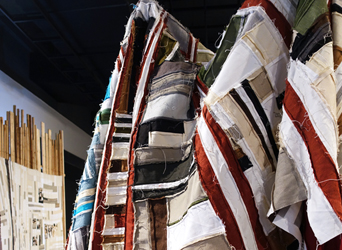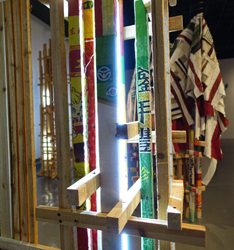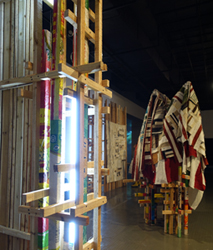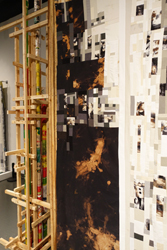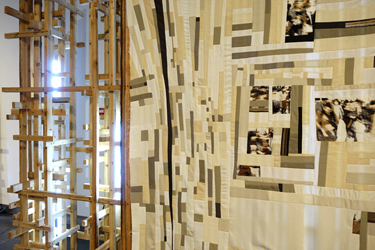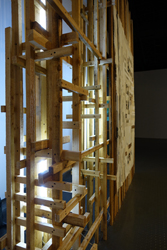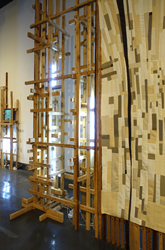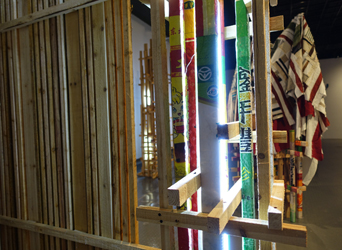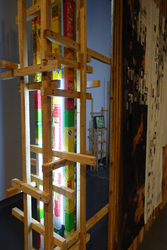Patched Up
|
The Second Triennial of Fibre Art
Zhejiang Art Museum Hangzhou China sept 2016 |
| |
| |
Conceptual fatigue has arrived. Practitioners who do not comfortably align themselves with craft as a discipline, or sit more comfortably between material disciplines, are questioning what was lost in the conceptual gold rush of recent decades. Taken in moderation this momentum towards the conceptual was arguably long overdue. Materials do carry meaning that goes beyond an appreciation of skilled production. The everyday role of textiles in particular infuse them with a wealth of stories – from mundane to extraordinary – many of which benefit from being conveyed by means other than written or spoken language. But along the way consideration of materials came to be seen as gauche. Conceptual craft became the only sanctioned version of contemporary craft – everything else woefully behind the times. But as Swedish artist Petter Hellsing recently observed, “I am tired of going to exhibitions that are better when read about.”
Hellsing’s past work embraced the potential of storytelling.  A Little Cabin in the Woods (2002-2004), for example, drew together the artist’s embroidered responses to his home in Flemingsberg, a suburb of Stockholm, alongside contributions from the local community. Stories of immigration and Sweden’s emerging multicultural identity were central to the project, which grew from Hellsing’s stitches into his facilitation of broad community engagement. More recent work has taken a distinctly different approach. While stories remain a motivating element, abstraction has begun to gain a far more prominent place. Reflecting on the Saxophone he played as a young man, Hellsing revised his thinking that improvisation belongs to music alone and has brought the strategy into his artistic practice. For someone quick to admit that he relishes the detail of small stitches, he now creates situations that force a loss of control. A Little Cabin in the Woods (2002-2004), for example, drew together the artist’s embroidered responses to his home in Flemingsberg, a suburb of Stockholm, alongside contributions from the local community. Stories of immigration and Sweden’s emerging multicultural identity were central to the project, which grew from Hellsing’s stitches into his facilitation of broad community engagement. More recent work has taken a distinctly different approach. While stories remain a motivating element, abstraction has begun to gain a far more prominent place. Reflecting on the Saxophone he played as a young man, Hellsing revised his thinking that improvisation belongs to music alone and has brought the strategy into his artistic practice. For someone quick to admit that he relishes the detail of small stitches, he now creates situations that force a loss of control.
More recent work has grown to combine textiles with materials such as wood sourced during the installation stage of an exhibition. Rather than arriving with finished artwork under his arm, Hellsing demands of himself a relationship with the local context and community to complete the installation. This new strategy pushes his work towards the collective rather than the individual. Inspired by the anarchic character of the textile found in temporary housing or market places, he builds on site – negotiating local realities to solve the practical material challenges at hand. The final work is less concerned with proving the stories behind the construction, instead trusting the rhythms and contrasts of a less literal, more abstract communication with the local audience. rather than the individual. Inspired by the anarchic character of the textile found in temporary housing or market places, he builds on site – negotiating local realities to solve the practical material challenges at hand. The final work is less concerned with proving the stories behind the construction, instead trusting the rhythms and contrasts of a less literal, more abstract communication with the local audience.
“Is it possible to use the abstract to discuss the political?” Hellsing muses. The question is on-going, tempered now by a different relationship with time that informs his latest work. “If I don’t finish it, someone else will,” he reflects on a new found acceptance that his artistic production contributes to a much larger continuum. Desire to work with local materials and reflect on the patterns and structures that surround us bring the readymade, randomness and material reuse to the centre of this work. “I’m not making – I’m combining to make new,” he explains of this purposeful scavenging. Professor Jessica Hemmings
June 2016
|
 story ˈstɔːri/ noun plural noun: stories story ˈstɔːri/ noun plural noun: stories 1. an account of imaginary or real people and events told for entertainment.
"an adventure story" synonyms: tale, narrative, account, recital, a plot of storyline. “the novel has a good story” synonyms: plot, storyline, scenario, chain of events; technical diegesis 2. a piece of gossip; a rumour. “there have been lots of stories going around, as you can imagine” synonyms: rumour, piece of gossip, piece of hearsay, whisper; more informal a false statement; a lie “Ellie never told stories – she had always believed in the truth” synonyms: lie, fib, falsehood, untruth, fabrication, fiction, piece of fiction.
 collective kəˈlɛktɪv/adjective 1. done by people acting as a group. “a collective protest” noun 1. a cooperative enterprise “the anarchist collective and bookshop” collective kəˈlɛktɪv/adjective 1. done by people acting as a group. “a collective protest” noun 1. a cooperative enterprise “the anarchist collective and bookshop”
 scavenge ˈskavɪn(d)ʒ/ verb gerund or present participle: scavenging 1. Search for and collect (anything usable) from discarded waste. “people sell junk scavenged from the garbage” synonyms: rummage, search, hunt, look, forage, root about/around, scratch about/around, grub about/around. scavenge ˈskavɪn(d)ʒ/ verb gerund or present participle: scavenging 1. Search for and collect (anything usable) from discarded waste. “people sell junk scavenged from the garbage” synonyms: rummage, search, hunt, look, forage, root about/around, scratch about/around, grub about/around.
|
|
|
|
|
| "WEAVING & WE" HANGZHOU TRIENNIAL OF FIBER ART |
| |
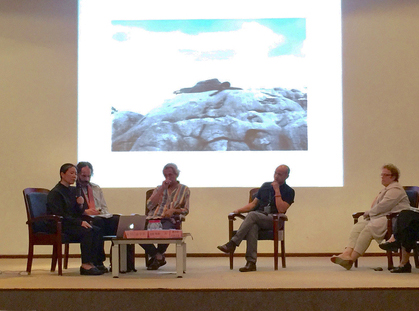 |
| |
| Artist talk with: (left to right) KIM SOOJA, HEW LOCKE and PETTER HELLSING, along with moderator YING JINFEI, deputy curator of Zhejiang Art Museum, Hangzhou. |
| |
| www.artasiapacific.com |
| |
|
The genre of fiber art tends to be categorized as craft and generalized as a form of outsider art. But in recent years, art historians have developed a more complete theory and vocabulary for fiber art, so that the art form can now plant deeper roots in the wider art historical narrative. In Asia, the Hangzhou Triennial of Fiber Art, now in its second edition, is paving the way for broader conversation and analysis. Hosted in a city reputed for its silk production and textile craftsmanship, the Hangzhou Triennial of Fiber Art debuted in 2013 as a platform to bridge this seemingly "traditional" art with the contemporary, by not only featuring works of artists shown in other international exhibitions, but also showcasing the ways in which interpretations of fiber art are diverse and address issues that are relevant today. For this year's Triennial, the focus is on the notion of weaving.
Over the course of two days, the Hangzhou Triennial of Fiber Art also hosted an international symposium on fiber art entitled "Textile Thinking". The symposium wrapped up with an artists' panel discussion that included Triennial participating artists Kim Sooja, Hew Locke and Petter Hellsing, who each explored an area of their practice in depth. Kim delved into her bottari series, which she first began in 1983 after helping her mother make a bedspread. She described that first instance of pushing a needlepoint into silk fabric as an experience where her "whole body was completely struck by universal energy." Meanwhile, Locke shared his fascination with crochet, an art form that had been previously neglected, but is now considered trendy. Hellsing described how he developed an interest in textiles during a trip to Guatemala, where he witnessed a community-driven approach to their creation process—a technique that informs the artist's current practice |
|
|

